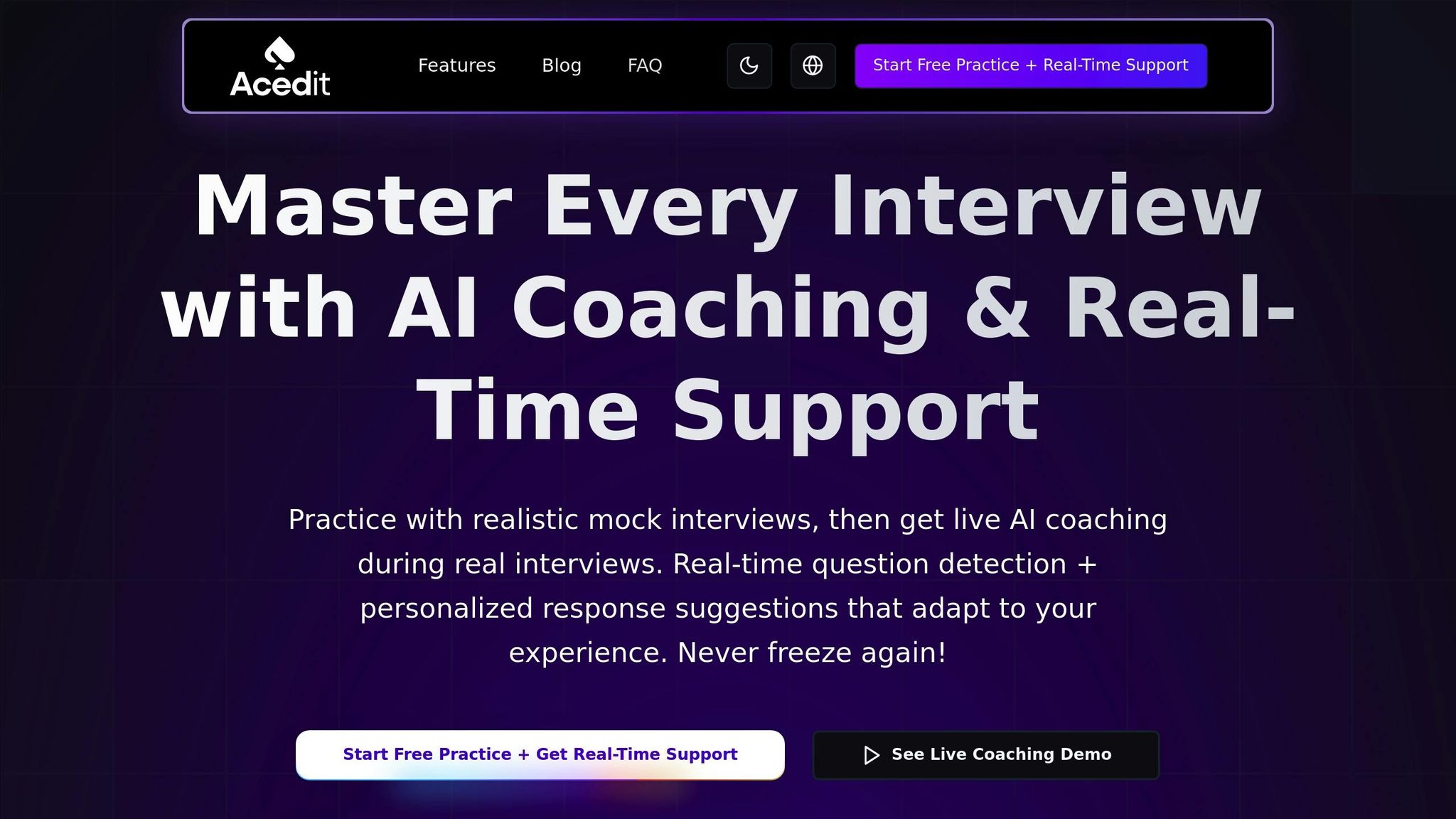2025年において、目立つ履歴書を作成することは、明確性、ATS互換性、採用担当者への訴求力のバランスを取ることです。Fortune 500企業の99%がAIスクリーニングツールを使用し、履歴書の75%が人間に届く前に却下される中、レイアウトが注目されるかどうかを決定します。知っておくべきことは以下の通りです:
- シンプルに保つ: クリーンなフォント(例:Arial、Calibri)、一貫したフォーマット、十分な余白。
- 単一列レイアウト: ATS互換性と金融や法律などの業界に最適。2列レイアウトはクリエイティブな職種に適している場合がありますが、解析の問題が生じるリスクがあります。
- ATS対応デザイン: 連絡先などの重要な情報にはグラフィック、表、ヘッダーを避ける。標準的なファイル形式(.docx、PDF)と一貫した日付形式(MM/YYYY)を使用。
- キーワード最適化: 求人情報と関連するスキルや用語を一致させてATSランキングを向上。
- AIツール: Aceditなどのプラットフォームは、フォーマットを改善し、キーワードを提案し、より良い結果のために読みやすさを向上させることができます。
採用担当者は履歴書をスキャンするのに6-7秒しかかけないため、レイアウトを明確で簡潔、そして仕事に合わせて調整することが重要です。よく設計された履歴書は、AIフィルターを通過し、採用マネージャーに印象を与える可能性を高めます。
2025年のATSスキャナーに最適な履歴書テンプレート(サンプルテンプレートと例)
現代の履歴書レイアウトの基本原則
2025年の履歴書は、応募者追跡システム(ATS)と人間の採用担当者の両方にアピールする必要があります。これらのガイドラインに従うことで、今日の競争の激しい就職市場で期待される専門的基準を満たしながら、履歴書が注目を集めることを保証します。
明確でシンプルなデザイン
現代の履歴書はシンプルさで成功します。説明的な見出し、箇条書き、十分な余白を持つクリーンなレイアウトは、履歴書を読みやすくします[1]。Fortune 500企業のほぼすべてがATSに依存していることを考慮すると[6]、機能性は派手なデザインよりも優先されるべきです。
適切なフォントを選ぶことが重要です。CalibrやArialなどのサンセリフオプションは洗練された現代的な外観を与え、HelveticaやTimes New Romanなどのクラシックは信頼できる選択肢です[4]。分かりやすいセクションタイトルにこだわり、自動システムを混乱させる可能性のある過度にクリエイティブな見出しや精巧なデザイン要素は避けてください。採用担当者が履歴書をスキャンするのに平均わずか7.4秒しかかけないことを考えると[5]、デザインは即座にあなたの価値を強調する必要があります。
これらのデザイン選択の一貫性は、読みやすさを助けるだけでなく、専門的なイメージも強化します。
全体を通した一貫したフォーマット
統一されたフォーマットは、洗練された信頼できる履歴書に不可欠です。同じフォントを全体で使用 - 本文テキストには10-12ポイント、ヘッダーには14-16ポイント。一貫したスペーシングを維持し、レイアウトが保たれるようにPDFとして履歴書を保存してください[4][2]。これらの詳細は米国の履歴書基準に合致し、強い印象を与えるのに役立ちます。
米国フォーマット基準
米国の就職市場をターゲットにしている場合、履歴書を現地の好みに合わせることが必須です。米国レターサイズ(8.5″ x 11″)を使用し、履歴書を1-2ページに収め、バランスの取れたレイアウトのために1インチのマージンを設定してください[3][4]。1から1.15の行間隔は、クリーンで読みやすい外観を作ります[2]。
さらに、現地の期待に応えるためにアメリカ英語のスペリング(例:「colour」の代わりに「color」)を使用してください[3][4]。キャリア専門家のジャスミン・エスカレラ博士は、役割に合わせて履歴書を調整することの重要性を強調しています:
"応募する特定の仕事に合わせて時系列履歴書を調整することは重要であり、最も関連性の高い経験と成果を示しながら、雇用主のニーズを理解していることを実証します。" [4]
時系列形式は、ATSと採用担当者の好みの両方に合致するため、米国で最も広く受け入れられています[3][4]。最後に、太字、斜体、色を思慮深く一貫して使用し、結婚歴、生年月日、性別、写真、宗教などの個人的な詳細は除外してください - これらは偏見や差別につながる可能性があります[3]。
視覚的魅力と機能性のバランス
注目を集めながら機能性を保つ履歴書を作成することは簡単ではありません。平均的な企業の求人投稿は250通の履歴書を集めるため、視覚的に目立つことが重要です。しかし、ここがコツです:デザインの選択が読みやすさやATS(応募者追跡システム)互換性を妨げてはいけません。適切なバランスを取ることは、どのデザイン要素が機能し、どれが機能しないかを知ることを意味します。
最適なフォントとレイアウトの選択
専門的な履歴書の基盤は適切なフォントから始まります。2025年には、Arial、Calibri、またはHelvetica - 画面上でも印刷でもよく機能するクリーンで読みやすいオプションを選んでください。本文テキストには10-12ポイント、ヘッダーには14-16ポイントにこだわってください[7][10]。これらのフォントは視覚的に魅力的なだけでなく、ATS対応でもあります。
余白に注意を払ってください。混雑した履歴書は、採用担当者にもATSにも読みにくくなります。余白はスキャンを容易にし、セクションが正しく解析されることを保証します[7][8]。読者を導くために明確なセクションヘッダーを使用し、全体を通して一貫したフォーマットを維持してください[10]。
最終決定する前に、履歴書をプレーンテキストとして保存して、コンテンツが整理されたままかどうかを確認してください。セクションが混乱して見える場合は、すべてが適切に整列するまでフォーマットを調整してください[9]。
色とデザイン要素の賢い使用
色は履歴書を際立たせることができますが、微妙さが重要です。見出しや区切り線には1-2のアクセントカラー - 青、グレー、緑など - を使用し、メインテキストは黒のままにしてください。白い背景に黒いテキストと単一のアクセントカラーが完璧なバランスを取ります[7]。
ミニマリストデザインは、ATS読みやすさと採用担当者の関心の両方にとって最良の選択です[8][10]。ResumeBuilder.comによると、クリーンなレイアウトと十分な余白を持つ履歴書は、ATSスクリーニングを通過し、採用マネージャーの目を引く可能性が高いとされています[8]。
履歴書にグラフィックや画像を過度に使用することは避けてください。これらは魅力的に見えるかもしれませんが、履歴書を分析のためにプレーンテキストに変換することが多いATSシステムを混乱させる可能性があります[11]。代わりに、シンプルなデザイン要素と控えめな色を使用して重要なセクションを強調してください。避けるべき一般的な落とし穴には、フォントや色の使いすぎ、一貫性のないフォーマット、ページにテキストを詰め込みすぎることが含まれます[7][10]。
単一列対2列レイアウト
履歴書のレイアウトは、その外観とATSでのパフォーマンスの両方に影響を与える可能性があります。単一列と2列レイアウトの選択は、業界とターゲットとする役割によって異なります。
| レイアウトタイプ | ATS互換性 | 視覚的魅力 | 最適な用途 | 欠点 |
|---|---|---|---|---|
| 単一列 | 高 | 中程度 | ほとんどの業界、ATS重視 | クリエイティブデザインの余地が少ない |
| 2列 | 中程度/低 | 高 | クリエイティブな役割 | 解析の問題の可能性 |
単一列レイアウトは分かりやすく、人間とATSの両方にとって読みやすいです。ATSスクリーニングが一般的な金融、法律、政府などの業界に理想的です[9]。情報が上から下に自然に流れるため、応募数の多い役割にとって安全な選択です。
2列レイアウトは、視覚的インパクトが重要なマーケティングやデザインなどのクリエイティブな役割により適しています。よりコンパクトでダイナミックなプレゼンテーションが可能です。ただし、慎重に設計されていない場合、ATS解析で問題を引き起こす可能性があります[9][10]。
決定する際は、ターゲット業界について考えてください。従来の役割やATSに依存する企業の場合は、単一列形式にこだわってください。クリエイティブなポジションの場合、よく設計された2列レイアウトは、機能性を保ちながらデザインスキルを示すことができます。
レイアウトに関係なく、Microsoft WordやGoogle Docsなどのツールを使用すると、洗練された履歴書を簡単に作成できます。ヘッダーには組み込みスタイルを使用し、マージンを一貫して保ち(1インチが標準)、箇条書きとセクション区切りで情報を整理してください[10]。ATS互換性のために設計されたテンプレートも時間を節約し、履歴書が技術的要件を満たすことを保証できます。
sbb-itb-20a3bee
履歴書をATS対応にする
強力なデザインを作成した後、次のステップは履歴書がATS(応募者追跡システム)ソフトウェアをナビゲートできることを確認することです。採用担当者の99.7%がATSツールに依存して候補者を分類しているため、これは重要です[12]。驚くべき事実があります:資格のある応募者の75%がフォーマットの問題によりATSで却下されています[13]。良いニュースは?これらの問題の多くは、いくつかの簡単な調整で回避できることです。
主要なATS要件
ATSシステムは基本的なテキストリーダーのように履歴書を読むため、過度に複雑なデザインは情報を混乱させる可能性があります。.docxやPDFなどの分かりやすいファイル形式にこだわってください。これらはATSが処理しやすい形式です。
フォントの選択も大きな役割を果たします。標準的なフォントを使用することで、履歴書を失格にする可能性のある解析エラーを防ぐことができます。さらに、名前、電話番号、メールなどの重要な詳細をヘッダーやフッターに配置することは避けてください。これらはATSによってしばしば無視されるためです。代わりに、履歴書の本文に含めてください。日付については、「Spring 2025」などのあまり一般的でないスタイルではなく、一貫したMM/YYYY形式(例:03/2024)を使用してください。
"グラフィック、表、クリエイティブなフォントで履歴書を混乱させることほど、ATSで履歴書を失う確実な方法はありません。やりたくなるでしょうが、やらないでください!"
– Jazlyn Unbedacht、履歴書ライター&LinkedIn最適化[12]
グラフィック、表、テキストボックスは履歴書を視覚的に魅力的にするかもしれませんが、ATSシステムを混乱させることがよくあります。代わりに、箇条書きと明確なセクション区切りを使用したクリーンなフォーマットに焦点を当ててください。最後に、戦略的なキーワード使用でATSランキングを向上させてください。
キーワード配置方法
キーワードは履歴書とATSの間の橋渡しです。これらのシステムは、キーワードの関連性、頻度、配置に基づいて候補者をランク付けします[14]。適切なキーワードで履歴書を最適化することは大きな違いを生むことができます - この方法で調整された履歴書は47%多くの面接要請を受けます[16]。
頻繁に言及されるスキルと資格について求人情報を分析することから始めてください。例えば、「プロジェクト管理」が複数回現れる場合は、その正確なフレーズを履歴書に含めるようにしてください[15]。チャンスを最大化するために:
- 専門要約に3-5の主要キーワードを含める。
- スキルセクションに8-12の関連キーワードをリストする。
- 職歴の成果記述にキーワードを自然に織り込む。
例えば、「データ分析に取り組んだ」と言う代わりに、「データ分析のためのSQLクエリを開発し、運用効率を20%向上させた」と試してください[14]。より良いATS結果のためにハードスキルとソフトスキルの3:1の比率を目指してください[16]。職種が独特または不明確な場合は、元のタイトルとより一般的な同等のもの(例:「Sales Associate/Customer Service Representative」)の両方をリストしてください[15]。
ATSベストプラクティスと一般的な間違い
キーワードが配置されたら、ATS互換性を妨げる可能性のある一般的なエラーを避けることも同様に重要です。誤字や一貫性のないフォーマットは大きな警告サインです - 採用マネージャーの77%がエラーのある履歴書を却下します[12]。校正は交渉の余地がありません。
キーワードの詰め込みも避けるべき罠です。キーワードは不可欠ですが、履歴書にそれらを過度に使用すると読みにくくなり、スパムフィルターを作動させる可能性もあります[17]。同様に、すべての応募に汎用的な履歴書を使用することは間違いです。大企業の95%以上がATSを使用しているため[18]、各求人投稿に履歴書を調整することは目立つために不可欠です。
「職歴」、「学歴」、「スキル」などの標準的なセクション見出しも重要です。クリエイティブな代替案はATSシステムを混乱させ、情報を正しく分類することを妨げる可能性があります。
| 一般的なATS間違い | 失敗する理由 | より良いアプローチ |
|---|---|---|
| クリエイティブなセクションヘッダーの使用 | ATSが非標準ラベルを分類できない | 「職歴」などの標準ラベルを使用 |
| 一貫性のない日付フォーマット | タイムライン解析を混乱させる | MM/YYYY形式を一貫して使用 |
| ヘッダーに連絡先情報を配置 | ATSはしばしばヘッダーコンテンツをスキップ | 本文に連絡先詳細を含める |
| 汎用的な職務記述 | 特定のキーワード検索と一致しない | 各求人投稿に記述を調整 |
| キーワードの詰め込み | スパムフィルターを作動させ、読みやすさを妨げる | 成果記述内にキーワードを自然に統合 |
連絡先詳細を履歴書の本文内にプレーンテキストで配置し、キャリア履歴が明確になるように広く認識された職種にこだわってください。
履歴書レイアウト最適化のためのAI使用
ATS互換性のために履歴書を最適化したら、次のステップはAIでレイアウトを微調整することです。このアプローチは、目を引くデザインとATS対応フォーマットをシームレスに融合させます。興味深いことに、AI搭載履歴書ツールを使用した求職者は、手動で履歴書を作成した人と比較して、内定率が7.8%増加し、8.4%高い給与を得ました[19]。
レイアウトカスタマイゼーションのためのAIツール
AI履歴書ビルダーは、アルゴリズムと機械学習に依存して、あなたの入力を何千もの成功した履歴書と求人投稿に対して分析します。これらのツールは即座に提案を提供し、平凡な履歴書を採用担当者の注意を引く洗練された文書に変換するのに役立ちます。
AIは人間が見逃すかもしれないパターンを見つけるのが得意です。ターゲットキーワードを組み込み、フォーマットを最適化することで、AIは履歴書がATSフィルターを通過する可能性を50%高めることができます。さらに、AIフィードバックツールを使用する候補者は、面接コールバックが30%増加したと報告しています[21]。このATS互換性の向上と戦略的キーワード配置の組み合わせにより、履歴書がシステムと採用マネージャーの両方に響くことが保証されます。
例えば、Microsoft WordのCopilot機能を取り上げてみましょう。2025年1月、プロジェクト管理履歴書を改良する際、Copilotは「製品ライフサイクル管理」、「アジャイル手法」、「戦略的計画」などのキーワードを提案しました[20]。求人情報とあなたの既存コンテンツを分析することで、役割に合わせて履歴書を調整するための正確な追加を推奨します。
"Copilotで履歴書を最適化して、基本的な文章を魅力的な言語に変え、夢の仕事をより早く手に入れましょう。" - Microsoft [20]
AIツールは履歴書の構造と言語の改善にも優れています。汎用的な箇条書きをインパクトのある行動指向の記述に変換し、文法やスペルエラーを検出し、読みやすさを向上させるためのレイアウト改善を提案することができます。
しかし、すべてのAIツールが同じように作られているわけではありません。一部のプラットフォームはATSフィルターを通過しない可能性のある派手なデザインに焦点を当てる一方、他のプラットフォームは結果を保証するためにクリーンなフォーマットとキーワード最適化を優先します。Aceditのように、美学と機能性の適切なバランスを取るツールを選択してください。
Aceditが履歴書作成を改善する方法

Aceditは面接コーチング機能で最もよく知られていますが、強力な履歴書最適化ツールも提供しています。Aceditは職種固有の要件を分析して、雇用主が求めているものと履歴書が一致することを保証する、カスタマイズされた推奨事項を提供します。
AceditのAIはスキルギャップを特定し、あなたの資格を効果的に強調するコンテンツを生成できます。リアルタイム分析は特定の求人投稿に提案を適応させ、履歴書が常に関連性を保つことを保証します。さらに、LinkedInプロファイルとの統合により、あなたの専門ネットワークと業界トレンドを分析して現在の需要を反映するレイアウト改善を提案する、もう一つの洞察レイヤーが追加されます。
Aceditを際立たせるのは、実用的でパーソナライズされたガイダンスへの焦点です。画一的なテンプレートを提供する代わりに、あなたのキャリア目標とターゲット業界に合わせた推奨事項を提供します。これにより、履歴書が専門的に見えるだけでなく、面接機会を最大化するために戦略的に設計されることも保証されます。
業界固有のレイアウトカスタマイゼーション
レイアウトを改良するAIの能力は、特定の業界向けに履歴書を調整することまで拡張されます。各分野には履歴書デザインに対する独特の期待があり、AIツールはこれらのニュアンスを認識し、適応することに長けています。例えば、クリエイティブ専門家の履歴書は金融アナリストのそれとは大きく異なり、AIはこれらの異なるニーズに適したレイアウト提案を提供できます。
AIはコンテンツを最適化するだけでなく、業界トレンドに基づいてレイアウトの優先順位も調整します。技術的な役割では、認定とスキルを強調するかもしれませんし、営業職では、視覚的に魅力的な形式で成果と指標を強調するかもしれません。
様々な業界内の成功した履歴書を分析することで、AIはコンテンツフロー、セクション強調、視覚的階層のパターンを特定します。これにより、履歴書レイアウトが汎用的なデザイン原則ではなく、あなたの分野で実際に機能するものに基づいて情報を得ることが保証されます。
研究によると、88%の雇用主が履歴書にATS対応キーワードが不足しているために資格のある候補者を見逃しています[20]。AIはこれをさらに進めて、これらのキーワードが業界の期待に応えるレイアウトで提示されることを保証します。これには、余白の調整、セクションの再編成、または採用担当者が直感的に感じるレイアウトを作成するためのヘッダーの調整が含まれる場合があります。
最良の結果は、AI洞察とあなた自身の判断を組み合わせることから生まれます。AIを使用して改善の機会と業界固有の調整を特定しますが、常に提案を確認し、あなたの独特のスキルと経験を反映するように改良してください。このAIの精度と人間のタッチの融合により、すべての正しい理由で目立つ履歴書が作成されます。
結論:2025年に向けた適切な履歴書レイアウトの構築
2025年に目立つ履歴書を作成することは、明確性、ATS互換性、AIツールの賢い使用のバランスを取ることを意味します。採用担当者が履歴書をスキムするのにわずか7秒しかかけず、99.7%がATSフィルターに依存している中、デザインの選択があなたのチャンスを左右する可能性があります - 特に求人投稿が競争の激しい役割で250から1,200の応募者を集める市場では[23][22][24]。
シンプルでクリーンなデザインが重要です。十分な余白、明確な見出しを使用し、読みやすさとATS対応を保証するために標準的なファイル形式にこだわってください。現代のATSシステムと採用マネージャーは複雑な表やテキストボックスに苦労することが多いため、単一列レイアウトが最適です[25]。よく整理された形式により、履歴書が初期スクリーニングを通過し、さらなる改善のための堅実な基盤を提供します。
AIツールは履歴書を次のレベルに引き上げることができます。例えば、Aceditなどのプラットフォームは、最大のインパクトのためにレイアウトとコンテンツの両方を微調整するカスタマイズされた提案を提供します。
最も効果的な履歴書は、クリーンなフォーマットと戦略的キーワード使用、測定可能な成果、そしてあなたの個人ブランドを強調する簡潔な専門要約を組み合わせます。採用担当者があなたについてのより多くの情報に簡単にアクセスできるように、LinkedInプロファイルやオンラインポートフォリオへのリンクを含めることを忘れないでください。
今日のますますデジタル化する採用環境において、履歴書レイアウトはしばしば印象を与える最初の機会です。明確性に焦点を当て、ATS対応を保証し、AI洞察を活用することで、スクリーニングを通過するだけでなく、採用担当者の注意を引き、その重要な面接を獲得するのに役立つ履歴書を作成できます。
よくある質問
2025年に履歴書を視覚的に魅力的でATS対応にする最良の方法は何ですか?
2025年のATS要件に合致する専門的な履歴書を作成するには、クリーンで分かりやすいデザインを目指してください。ArialやTimes New Romanなどの標準フォントにこだわり、単一列形式を使用し、グラフィック、画像、または表や複数列デザインなどの複雑なレイアウトを避けてください。
見出し、箇条書き、全体を通した一貫したスペーシングを組み込むことで明確な構造を優先してください。異なるシステム間でアクセス可能であることを保証するために、履歴書をPDFまたはWordファイルとして保存してください。より良いATS互換性のために、求人情報から関連するキーワードを統合し、職歴を逆時系列順にリストしてください。この方法により、履歴書が読者にもATS対応にも保たれます。
履歴書でキーワードを効果的に使用してATSランキングを向上させるにはどうすればよいですか?
ATS(応募者追跡システム)で履歴書により良いチャンスを与えるために、求人情報から直接キーワードを含めるようにしてください。応募している役割に一致する特定のスキル、職種、認定、行動動詞に注意を払ってください。これらのキーワードを経験、成果、スキルなどのセクションに自然に織り込んでください。
シンプルでATS対応の形式にこだわってください - 画像、グラフィック、または過度に複雑なデザインの使用を避けてください。そして、キーワードは重要ですが、やりすぎないでください。それぞれがあなたの責任と成果の文脈内で意味をなすべきです。最後に、可能な限り関連性を保つために、すべての求人応募に対して履歴書をカスタマイズしてください。
AceditなどのAIツールは、履歴書のレイアウトとコンテンツの改善にどのように役立ちますか?
AceditなどのAIツールは、_応募者追跡システム(ATS)_とシームレスに機能するようにレイアウトとコンテンツを微調整することで、履歴書を次のレベルに引き上げるのに役立ちます。これらは求人情報をスキャンして重要なキーワードを特定し、明確性のためにフォーマットを改良し、履歴書が業界の期待に応えることを保証します。
さらに、Aceditは特定の役割に対して履歴書をカスタマイズするためのリアルタイムのヒントを提供し、採用担当者に目立つようにします。これらのツールはあなたの可視性を高め、面接を確保する可能性を向上させることができます。